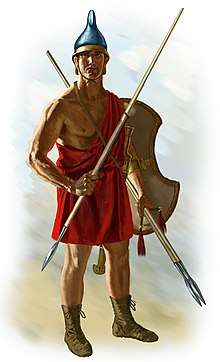Light infantry
Light infantry is a designation applied to certain types of foot soldiers (infantry) throughout history, typically having lighter equipment or armament or a more mobile or fluid function than other types of infantry, such as heavy infantry or line infantry. Historically, light infantry often fought as scouts, raiders and skirmishers—soldiers who fight in a loose formation ahead of the main army to harass, delay, disrupt supply lines, and generally "soften up" an enemy before the main battle. After World War II, the term "light infantry" evolved, and now generally refers to rapid-deployment units (including commandos and airborne units) that specifically emphasize speed and mobility over armor and firepower. Some units or battalions that historically held a skirmishing role have kept their designation "light infantry" for the sake of tradition.
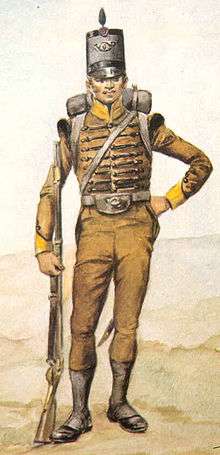
| Part of a series on |
| War |
|---|
|
|
|
Related
|
History
Ancient history
The concept of a skirmishing screen is a very old one and was already well-established in Ancient Greece and Roman times in the form, for example, of the Greek peltast and psiloi, and the Roman velites. As with the so-called "light infantry" of later periods, the term more adequately describes the role of such infantry rather than the actual weight of their equipment. Peltast equipment, for example, grew steadily heavier at the same time as hoplite equipment grew lighter. It was the fact that peltasts fought in open order as skirmishers that made them light infantry and that hoplites fought in the battle line in a phalanx formation that made them heavy infantry.
Modern history
Early regular armies of the modern era frequently relied on irregulars to perform the duties of light infantry skirmishers. In particular, the French Army employed detachments of German and Balkan mercenaries to serve as patrols in the rough country until a permanent corps of Mountain Fusiliers (Fusiliers des Montagnes) was raised in the 1740s.[1] In the 17th century, dragoons were sometimes employed as the skirmishers of their day – mounted infantrymen who rode into battle but dismounted to fight, giving them a mobility lacking to regular foot soldiers.[2]
In the 18th and 19th centuries most infantry regiments or battalions had a light company as an integral part of its composition. Its members were often smaller, more agile men with high shooting ability and capability of using initiative. They did not usually fight in disciplined ranks as did the ordinary infantry but often in widely dispersed groups, necessitating an understanding of skirmish warfare. They were expected to avoid melee engagements unless necessary and would fight ahead of the mainline to harass the enemy before falling back to the main position.
During the period 1777–1781, the Continental Army of the United States adopted the British Army practice of seasonally drafting light infantry regiments as temporary units during active field operations, by combining existing light infantry companies detached from their parent regiments.
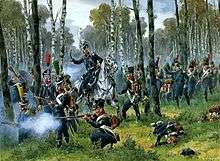
Light infantry sometimes carried lighter muskets than ordinary infantrymen while others carried rifles and wore rifle green uniforms. These became designated as rifle regiments in Britain and Jäger and Schützen (sharpshooter) regiments in German-speaking Europe. In France, during the Napoleonic Wars, light infantry were called voltigeurs and chasseurs and the sharpshooters tirailleurs. The Austrian army had Grenzer regiments from the middle of the 18th century, who originally served as irregular militia skirmishers recruited from mountainous frontier areas. They were gradually absorbed into the line infantry becoming a hybrid type that proved successful against the French, to the extent that Napoleon recruited several units of Austrian army Grenzer to his own army after victory over Austria in 1809 compelled the Austrians to cede territories from which they were traditionally recruited. In Portugal, 1797, companies of Caçadores (Hunters) were created in the Portuguese Army, and in 1808 led to the formation of independent "Caçador" battalions that became known for their ability to perform precision shooting at long distances.
Light infantry officers sometimes carried muskets or rifles, rather than pistols, and their swords were light curved sabres; as opposed to the heavy, straighter swords of other infantry officers. Orders were sent by bugle or whistle instead of drum (since the sound of a bugle carries further and it is difficult to move fast when carrying a drum). Some armies, including the British and French, recruited whole regiments (or converted existing ones) of light infantry. These were considered elite units, since they required specialised training with emphasis on self-discipline, manoeuvre and initiative to carry out the roles of light infantry as well as those of ordinary infantry.
By the late 19th century the concept of fighting in formation was on the wane due to advancements in weaponry and the distinctions between light and heavy infantry began to disappear. Essentially, all infantry became light infantry in operational practice. Some regiments retained the name and customs, but there was in effect little difference between them and other infantry regiments.
On the eve of World War I the British Army included seven light infantry regiments. These differed from other infantry only in maintaining such traditional distinctions as badges that included a bugle-horn, dark green home service helmets for full dress, and a fast-stepping parade ground march.[3]
Contemporary
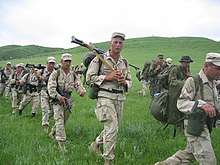
Today the term "light" denotes, in the United States table of organization and equipment, units lacking heavy weapons and armor or with a reduced vehicle footprint. Light infantry units lack the greater firepower, operational mobility and protection of mechanized or armored units, but possess greater tactical mobility and the ability to execute missions in severely restrictive terrain and in areas where weather makes vehicular mobility difficult.
Light infantry forces typically rely on their ability to operate under restrictive conditions, surprise, violence of action, training, stealth, field craft, and fitness levels of the individual soldiers to address their reduced lethality. Despite the usage of the term "light", forces in a light unit will normally carry heavier individual loads versus other forces; they must carry everything they require to fight, survive and win due to lack of vehicles. Although units like the 101st Airborne (Air Assault) and the 82nd Airborne Division are categorized as Air Assault Infantry and Airborne Infantry respectively, they fall under the overall concept of light infantry. They are typically infantry intended for difficult terrain such as mountains or arctic conditions (US Marines) (Royal Marines, United States Army 10th Mountain Division, United States Army 86th Infantry Brigade Combat Team (Mountain), Italian Army Alpini, French Army 27ème bataillon de chasseurs alpins) or jungle (Philippine Army Scout Rangers, Brazilian Army Jungle Infantry Brigades).
In the 1980s, the United States Army increased light forces to address contingencies and increased threats requiring a more deployable force able to operate in restrictive environments for limited periods. At its height, this included the 6th Infantry Division (light), 7th Infantry Division (light), 10th Mountain Division (light infantry), 25th Infantry Division, and the 75th Ranger Regiment. Operation Just Cause is often cited as proof of concept. Almost 30,000 U.S. Forces, mostly light, deployed to Panama within a 48-hour period to execute combat operations. On 30 September 1985, the 29th Infantry Division (Maryland and Virginia Army National Guard) was reactivated at Fort Belvoir, Virginia as the only light Infantry Division in the US Army’s reserve components.
During the Falklands War in 1982, both Argentina and the United Kingdom made heavy use of light infantry and its doctrines during the campaign, most notably the Argentine 5th Naval Infantry Battalion (Argentina) and 25th Infantry Regiment (Argentina) and the British Parachute Regiment and Royal Marines of 3 Commando Brigade. Due to the rocky and mountainous terrain of the Falkland Islands, operations on the ground were only made possible with the use of light infantry because the use of mechanized infantry or armour was severely limited by of the terrain, leading to the "Yomp" across the Falklands, in which Royal Marines and Paras yomped (and tabbed) with their equipment across the islands, covering 56 miles (90 km) in three days carrying 80-pound (36 kg) loads after disembarking from ships at San Carlos on East Falkland, on 21 May 1982.
During the 1990s, the concept of purely light forces in the US military came under scrutiny due to their decreased lethality and survivability. This scrutiny has resulted in the Stryker Brigade Combat Team, a greater focus on task organized units (such as Marine Expeditionary Units) and a reduction of purely light forces.
Despite their reduction, light forces have proven successful in Afghanistan (Operation Enduring Freedom), underlining the continued need for light infantry.
National examples
Argentina
- Mountain Huntsmen, in Spanish: Cazadores de Montaña
- Jungle Huntsmen, in Spanish: Cazadores del Monte
Belgium
- 12th-13th Battalion of the Line
- 1st Regiment Jagers te Paard, mechanized reconnaissance battalion
- 2nd/4th Regiment Mounted Rifles, mechanized reconnaissance battalion with electronic warfare unit
Brazil
There are three light infantry brigades, (4ª Brigada de Infantaria Leve de Montanha, 11ª Brigada de Infantaria Leve and 12ª Brigada de Infantaria Leve Aeromóvel), and an airborne infantry brigade (Brigada de Infantaria Paraquedista). The 12º Light Infantry Brigade and the Airborne Infantry Brigade both belong to the Força de Ação Rápida Estratégica (Quick Strategic Action Force), which is composed of units capable of rapidly engaging in combat anywhere in Brazil.
Canada
Each of the three regular army regiments (Princess Patricia's Canadian Light Infantry, Royal Canadian Regiment and Royal 22e Régiment) maintains their third battalion as light infantry capable in airborne, mountain, and amphibious operations, with varying degrees of capability. All reserve infantry units are classed as light infantry, all with varying degrees of capability.
Denmark
Finland
- Finnish Jäger troops, volunteers from Finland in Germany trained as Jägers
- Guard Jaeger Regiment or Huntsmen's Guard Regiment, a Finnish Army unit
- Jaeger Brigade, a unit of the Finnish Army
- Para Jägers, Special Operations Airborne Infantry in the Finnish Army
- Utti Jaeger Regiment, the Finnish Army training and development centre for special forces and helicopter operations
- Sissi troops can also be considered light infantry
Finnish infantry units are also known as Jäger (Finnish pl. Jääkärit, Swedish pl. Jägarna), a legacy of a Finnish volunteer Jäger battalion formed in Germany during World War I to fight for the liberation of Finland from Russia.
France
Ancien régime
The Chasseur designation was given to certain regiments of French light infantry (Chasseurs à pied) or light cavalry (Chasseurs à cheval).
The Chasseurs à pied (light infantry) were originally recruited from hunters or woodsmen. The Chasseurs à Pied, as the marksmen of the French army, were considered an elite.[4] The first unit raised was Jean Chrétien Fischer's Free Hunter Company in 1743. Early units were often a mix of cavalry and infantry. In 1776, all Chasseurs units were re-organized into six battalions, each linked to a cavalry regiment (Chasseurs à cheval). In 1788, the link between infantry battalions and cavalry regiments was broken.
Revolution and Napoleon

In 1793, the Ancien Régime's Chasseur battalions were merged with volunteer battalions in new units called Light Infantry half-brigades (demi-brigades d’infanterie légère). In 1803, the half-brigades were renamed regiments. These units had three battalions of three regular Chasseurs companies, one elite Carabiniers company and one reconnaissance voltigeurs company.
In Napoléon's Imperial Guard, many units used names linked to light infantry:
- Chasseurs à pied: three regiments (1809–1815; 1815–1815; 1815–1815). The regiments were the elite of the light infantry regiments.
- Fusilier-Chasseurs: a single regiment, originally the first Guard Fusilier Regiment (1809–1815)
- Voltigeurs: 16 regiments, originally two regiments of Tirailleurs-chasseur and two regiments of Conscrits-chasseurs (1810–1815), then twelve new regiments (1811–1815). These regiments were expected to become Chasseurs à pieds.
- Flanqueurs-Chasseurs: two regiments, from drafted Forest Service members (1811–1815; 1813–1815)
19th century
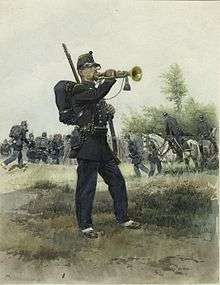
The Napoleonic light infantry regiments existed until 1854, but there were very few differences between them and the line infantry regiments, so the 25 remaining light infantry regiments were transformed to line infantry in 1854.
- Chasseurs à pied: The Duke of Orléans, heir to the throne, created in 1838 a new light infantry unit, the Tirailleurs battalion. It soon became, under the name Chasseur à Pied, the main light infantry unit in the French Army. The number of battalions grew up steadily through the century. The current Chasseurs battalions drew their lineage form this unit.
- Chasseurs alpins: Some of Chasseurs à pied battalions were converted to specialized mountain units as Bataillons de Chasseurs Alpins in 1888, as an answer to the Italian Alpine (Alpini) regiments stationed along the Alpine frontier.
- Chasseurs Forestiers: The Chasseurs forestiers (Forest Huntsmen) were militarized units of the Forest Service. They were organized in companies. They existed between 1875 and 1924.
- Infanterie Légère d'Afrique (African Light Infantry) were penal battalions forming part of the French forces serving in North Africa. These units were recruited mainly from convicted military criminals from all branches of the French Army, who had finished their sentences in military prisons but still had time to serve before their engagement periods were finished.[5]
- Zouaves: The Zouaves battalions and regiments were colonial troops, formed originally by Algerians, then by European settlers and colonists. The first Zouave battalion was created in 1831 and changed its recruiting to Europeans in 1841. During the Franco-Austrian War of 1859, effective use was made of Zouaves and Chasseurs à pied (see above) in evolving light infantry tactics that went further than merely screening the main battle line. At the Battle of Solferino these newly organized skirmishers operated as independent groups that were able to disrupt their Austrian opponents by sudden flank assaults.[6]
- Tirailleurs: Tirailleurs (Skirmishers) were light infantry who formed a shallow line ahead of the line of battle during the Revolutionary/Napoleonic Wars and subsequently. The name was also used for the locally recruited colonial troops in the French Empire between 1841 and 1962.
20th century
- Chasseurs à pied: The Chasseurs à pieds evolved during the mid 20th century into mechanized infantry units (Chasseurs mécanisés) or armored division infantry (Chasseurs portés). After World War Two, all Chasseur units were organized on the mechanized infantry model.
- Chasseurs alpins: The Chasseurs alpins, mountain warfare units of the French Army created in 1888.
- Chasseurs pyrénéens and Chasseurs pyrénéens were the short-lived (1939–1940) mountain warfare units formed in the Pyrénées.
- Chasseurs-Parachutistes: The Chasseurs-parachutistes were airborne infantry units formed in 1943 from Air Force infantry compagnies transferred to the Army.
- Zouaves and Tirailleurs: After the independence of the countries that made up the French Colonial Empire, the Zouaves and the Tirailleurs units, save for one, were disbanded.
Modern French Army Light Infantry
- 7th Chasseurs Alpins Battalion
- 13th Chasseurs Alpins Battalion
- 16th Chasseur Battalion
- 27e bataillon de chasseurs alpins
- 1st Tirailleur Regiment
- 1st Parachute Chasseur Regiment
Although the traditions of these different branches of the French Army are very different, there is still a tendency to confuse one with the other. For example, when World War I veteran Léon Weil died, the AFP press agency stated that he was a member of the 5th "Regiment de Chasseurs Alpins". It was in fact the 5th Bataillon.
Germany
India
The Indian Army of 1914 included ten regiments with "Light Infantry" in their titles. These were the:
- 2nd Queen Victoria's Own Rajput Light Infantry
- 5th Light Infantry
- 6th Jat Light Infantry
- 63rd Palamcottah Light Infantry
- 83rd Wallajahabad Light Infantry
- 91st Punjabis (Light Infantry)
- 103rd Mahratta Light Infantry
- 105th Mahratta Light Infantry
- 110th Mahratta Light Infantry
- 127th Baluch Light Infantry
Most of these regiments lost their separate identity as a result of extensive amalgamations in 1922. The modern Indian Army retains the Maratha Light Infantry and the Sikh Light Infantry.
Of the 28 infantry regiments of the modern Indian Army, the following ten are designated as "Rifles". They are distinguished by their black rank badges, black buttons on their service and ceremonial uniforms and a beret in a darker shade of green than other regiments. Two paramilitary forces—the Assam Rifles and the Eastern Frontier Rifles—also follow the traditions of a rifle regiment.
- Rajputana Rifles
- Garhwal Rifles
- 1st Gorkha Rifles (The Malaun Regiment)
- 3 Gorkha Rifles
- 4 Gorkha Rifles
- 5 Gorkha Rifles (Frontier Force)
- 8 Gorkha Rifles
- 9 Gorkha Rifles
- 11 Gorkha Rifles
- Jammu and Kashmir Rifles
- Jammu and Kashmir Light Infantry
- Maratha Light Infantry
- Sikh Light Infantry
Ireland
The Irish famously employed "Cethernacht" or Kern as light infantry. These usually made up the bulk of Gaelic and even later Anglo Norman Irish armies during the middle ages to renaissance era's. Traditionally armed with javelins and swords while wearing no armour, in later periods they were equipped with caliver muskets while still using little to no armour. They were notably effective while employed in tandem with heavily armed "Galloglaich" or anglicised Gallowglass. They could provide effective support to heavily armed troops as well as endlessly harassing enemies in difficult terrain. Today, all infantry battalions of the Irish Army are light infantry soldiers.
Italy
Most of the states of the Italian peninsula had their own units of skirmishers before Italian unification. One of the few that survived it were the Sardinian Bersaglieri, who were formed in 1836. They became some of the most iconic soldiers in Italian Army and were its "quick reaction force". The Alpini are the Italian Army's elite mountain troops, founded in 1875. Although they may not seem a true "light infantry" unit, (they were assigned their own artillery, carried double load of everything, and had a slower marching pace of 45 steps per minute), the Alpini were trained as jagers and skirmishers, introducing the use of skis and climbing training for all of their recruits. Those two corps still exist today, but in the years the Bersaglieri, have become a mechanised infantry unit, working closely with armoured units, and up until the mid-1990s had their own tank and artillery units. Other units that can be classified as light infantry are:
- The ''Folgore'' Parachute Brigade, created in 1963, is the only airborne unit in the Italian Army. Apart from one light cavalry regiment, it comprises three airborne infantry and two special force regiments.
- The Friuli Air Assault Brigade was originally an Italian Army mechanised brigade. In 2000 it converted to a fully airmobile role and is part of the "Friuli" Division. It is composed of three light aviation regiments and one infantry regiment—66th Reggimento Fanteria Aeromobile "Trieste"—the only regiment in the Italian Army to be fully airmobile.
- The San Marco Marine Brigade of the Italian Navy comprises three regiments. The First is an amphibious assault unit, the Second carries out force protection, boarding and search and seizure procedures on ships and the Third is a training unit. Given that it has almost only light vehicles (the heaviest being the amphibious Arisgator and AAV7 landing vehicles) and is tasked to operate in harsh terrain (shore lines, lagoons, deserts, mountains, jungles), it is one of the purest "light infantry" units in the Italian Armed Forces.
- The 13th and 7th regiments of the Carabinieri were created during WW2 as highly mobile infantry. They are still deployed to war zones as light infantry and military law enforcement units. The Carabinieri also have some domestic law enforcement units trained as light or airmobile infantry. The Squadrone Eliportato "Cacciatori di Calabria (nicknamed the Falchi d'Aspromonte, meaning "Hawks of the Aspromonte") is tasked with opposing the "Camorra" criminal organisation, who are numerous and typically armed with military-grade weapons acquired on the black market, and operate deep within the mountainous region of the Aspromonte. The Squadrone Eliportato Cacciatori di Sardegna was created by the Carabinieri to reduce the spree of banditism (mainly kidnapping) that afflicts the innermost areas of Sardinia.
Netherlands
- Garderegiment Grenadiers en Jagers, guards regiment, an amalgamation of the Garderegiment Grenadiers and the Garderegiment Jagers. Consists of one air mobile infantry battalion
- Regiment Limburgse Jagers, line infantry (former 2nd Infantry Regiment). Consists of one armoured infantry battalion
Norway
- Hærens Jegerkommando, the armed forces competence center for ranger, airborne and counter-terrorist duty in the Norwegian Army
- Jegerkompaniet, the Norwegian Army's northern-most unit
- Marinejegerkommandoen, a maritime special forces unit
- Kystjegerkommandoen, coastal units
- Grensejeger, border rangers at the border between Russia and Norway
Poland
- Wojska Obrony Terytorialnej, Territorial Defence Force 17 light infantry brigades
Portugal
Portuguese Riflemen were known as Caçadores literally "Huntsmen". Portuguese Caçadores battalions were the elite light soldiers of the Portuguese Army during the Peninsular War. They wore distinctive brown uniforms for camouflage. They were considered, by the Duke of Wellington, as the "fighting cocks of his army". Each Caçadores battalion included an elite company armed with rifles known as atiradores (literally "Shooters").
In the first half of the 20th century the Caçadores battalions were recreated as border defense units. In the 1950s, the title "Caçadores" was also given to the light infantry battalions and independent companies responsible for garrisoning overseas territories. Colonial troops with this title were recruited from both Portuguese settlers and from indigenous populations. In the 1950s, the Portuguese Air Force formed a unit of paratroopers called Caçadores Paraquedistas ("Parachutist Hunters"). Battalions of Caçadores Paraquedistas were later created in Angola, Mozambique and Portuguese Guinea. At the beginning of the 1960s, several special forces companies of the Portuguese Army were named "Special Huntsmen" (Caçadores Especiais). These units wore a brown beret in the colour of the uniforms of the caçadores of the Peninsular War. These units were later abolished and the brown beret started to be used by most of the units of the Portuguese Army.
In 1975, the designation "Caçadores" was discontinued in the Portuguese Armed Forces. All former units of caçadores were redesigned as "Infantry". Currently, every infantry soldier of the Portuguese Army is known as atirador.
Rhodesia
The Rhodesian Light Infantry was a regular regiment of the Rhodesian Army, unique in having the traditions of light infantry while serving as a modern Commando regiment.
Romania
- Vânători de Munte, or "Mountain Huntsmen" comprised elite units of the Romanian infantry prior to 1945.
Russia
The Imperial Russian Army, which was heavily influenced by the Prussian and Austrian military systems, included fifty Jäger or yegerskii [егерский] regiments in its organisation by 1812, including the Egersky Guards Regiment. They were mostly united with line infantry regiments in 1833, when almost all Russian infantry began to receive the same training; including skirmishing. At the same time strelkovyi [стрелковый] battalions were introduced. These undertook light infantry functions when the skirmishing skills of line infantry were insufficient.
Spain
Historically the Spanish infantry included several battalions of light infantry that were designated as Cazadores. These units were incorporated into the ordinary infantry following army reorganization in the early 1930s. Until 2006 the modern Spanish Army maintained a Brigada de Cazadores de Montaña "Aragón I" (Mountain Huntsmen Brigade "Aragón I")
Sweden
- Jägare, elite units in the Swedish Armed Forces
- Fallskärmsjägarna, the Parachute Rangers
- Swedish Parachute Ranger School
- Ö-Nerike skvadron, Intelligence squadron
- Vadsbo skvadron, Airborne squadron
- Army Ranger Battalion, Arctic warfare rifles
- Kustjägarna, Coastal Rangers
Somalia
- Danab, which translates to "Lightning" are the elite commandos units of the Somali Armed Forces.
United Kingdom
The British Army first experimented with light infantry in the French and Indian War, to counter the tactics used by the French-allied Native Americans. Along with secondment of regular infantry, several specialised units were raised (including Rogers' Rangers and the 80th Regiment of Light-Armed Foot), though most if not all had been disbanded by the middle of the 1760s. From 1770, all regular battalions were required to designate one of their ten companies a "Light Company", though their training in skirmishing was poor and inconsistent.
Dedicated rifle and light infantry regiments began to be formed or converted in the Napoleonic Wars, to counter the French Chasseurs. A new battalion of the 60th Royal Americans (later the King's Royal Rifle Corps) was raised in 1797, and an "Experimental Corps of Riflemen" (later the 95th Rifles and then the Rifle Brigade) in 1800. Both were equipped with green jackets and Baker rifles. Some extant regiments began to be designated "Light Infantry" at this point, receiving skirmishing training but generally still equipped with red coats and muskets. In the Peninsular War, a Light Brigade and later a Light Division were formed, at some points incorporating Portuguese Caçadores. By the Crimean War, rifles had become universal and tactics had substantially changed. This meant that the distinctions between light and line infantry were effectively limited to details such as name, a rapid march of 140 steps per minute, buglers instead of drummers and fifers, a parade drill which involved carrying rifles parallel to the ground ("at the trail") and dark green cloth helmets instead of dark blue. Light infantry badges always incorporated bugle horns as a central feature.[7]
In the Second World War, the use of light infantry was revived in what became the British Commandos and the Parachute Regiment. Because of the nature of their role and deployment, they were more lightly equipped than most infantry battalions. The Parachute Regiment has survived to this day, while the Royal Marine Commandos are directly descended from those units formed in the Second World War.
Most of the old light infantry and rifle regiments were administratively grouped in a new Light Division in 1968. The British Army ordered regimental amalgamations in 1957, 1966, 1990 and 2003. The Rifles (the largest infantry regiment in the British Army) was formed in 2007 from the amalgamation of the regiments of the Light Division. The Rifles maintain the traditional quick parade march of all British light infantry, the Rifle Brigade's "rifle green" No 1 dress with blackened buttons and black leather belts, and many other traditions and "golden threads" of its parent regiments. Rifle and light infantry regiments that did not become part of the Rifles included the Royal Ulster Rifles, the Royal Gurkha Rifles, the Cameronians (Scottish Rifles) and the Highland Light Infantry.
Today, "Light role infantry" is a designation that can be applied to an infantry battalion of any regiment. Light role infantry are not (by default) equipped with armoured vehicles (unlike Armoured Infantry or Mechanised Infantry).
United States
In 1808, the United States Army created its first Regiment of Riflemen. During the War of 1812 three more Rifle Regiments were raised but disbanded after the war. The Rifle Regiment was disbanded in 1821.
In the Mexican–American War Colonel Jefferson Davis created and led the Mississippi Rifles.
Riflemen were listed as separate to infantry up to the American Civil War.[8]
During the Civil War, Sharpshooter regiments were raised in the North with several companies being raised by individual states for their own regiments.[9]
See also
| Wikimedia Commons has media related to Infantry. |
- Heavy cavalry
- Line infantry
- Light cavalry
- Roman infantry tactics, strategy and battle formations
References and notes
- Chartrand, Rene. Louis XV's Army (4) Light Troops and Specialists. p. 37. ISBN 1-85532-624-8.
- Chartrand, Rene. Louis XIV's Army. p. 37. ISBN 0-85045-850-1.
- Maj. R. M.Barnes, pp.298–305 "A History of the Regiments & Uniforms of the British Army", Sphere Books 1972
- Ross, Steven T. (1996). From Flintlock to Rifle: Infantry Tactics, 1740–1866. Taylor & Francis. ISBN 978-0-7146-4193-5.
- Jacques Sicard, page 46 "Les Bataillons d' Infanterie Legere d'Afrique et leurs insignes, 1832–1972", Militaria Magazine Septembre 1994
- Brooks, Richard. Soferino 1859. p. 12. ISBN 978-1-84603-385-8.
- Schollander, Wendell. Glory of the Empires 1880-1914. p. 143. ISBN 978-0-7524-8634-5.
- United States War Department Revised Regulations for the Army of the United States, 1861: With a Full Index J. G. L. Brown, printer, 1861
- Katcher, Philip; Walsh, Stephen (2002). Sharpshooters of the American Civil War 1861–65. Osprey Publishing. p. 4. ISBN 978-1-84176-463-4.
Further reading
- The Partisan in War, a treatise on light infantry tactics written by Colonel Andreas Emmerich in 1789.
